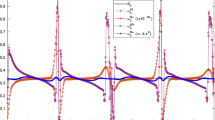Abstract
In spectral-like resolution-WENO hybrid schemes, if the switch function takes more grid points as discontinuity points, the WENO scheme is often turned on, and the numerical solutions may be too dissipative. Conversely, if the switch function takes less grid points as discontinuity points, the hybrid schemes usually are found to produce oscillatory solutions or just to be unstable. Even if the switch function takes less grid points as discontinuity points, the final hybrid scheme is inclined to be more stable, provided the spectral-like resolution scheme in the hybrid scheme has moderate shock-capturing capability. Following this idea, we propose nonlinear spectral-like schemes named weighted group velocity control (WGVC) schemes. These schemes show not only high-resolution for short waves but also moderate shock capturing capability. Then a new class of hybrid schemes is designed in which the WGVC scheme is used in smooth regions and the WENO scheme is used to capture discontinuities. These hybrid schemes show good resolution for small-scales structures and fine shock-capturing capabilities while the switch function takes less grid points as discontinuity points. The seven-order WGVC-WENO scheme has also been applied successfully to the direct numerical simulation of oblique shock wave-turbulent boundary layer interaction.
Similar content being viewed by others
References
Dolling D S. Fifty years of shock-wave/boundary-layer interaction research: What next? AIAA J, 2001, 39: 1517–1531
Sun Z S, Ren Y X, Larricq C, et al. A class of finite difference schemes with low dispersion and controllable dissipation for DNS of compressible turbulence. J Comput Phys, 2011, 230(12): 4616–4635
Fu D X, Ma Y W. A high order accurate difference scheme for complex flow fields. J Comput Phys, 1997. 134(1): 1–15
He Z W, Li X L, Fu D X, et al. A 5th order monotonicity-preserving upwind compact difference scheme. Sci China-Phys Mech Astron, 2011, 54(3): 511–522
Tam C K W, Webb J C. Dispersion-relation-preserving finite difference schemes for computational acoustics. J Comput Phys, 1993, 107: 262–281
Li Y. Wavenumber-extended high-order upwind-biased finite difference schemes for convective scalar transport. J Comput Phys, 1997, 133: 235–255
Lele S K. Compact finite difference schemes with spectral-like resolution. J Comput Phys, 1992, 103: 16–42
Honein A E, Moin P. Higher entropy conservation and numerical stability of compressible turbulence simulations. J Comput Phys, 2004, 201(2): 531–545
Kim S, Lee S, Kim K H. Wavenumber-extended high-order oscillation control finite volume schemes for multi-dimensional aeroacoustic computations. J Comput Phys, 2008, 227(8): 4089–4122
Jiang G S, Shu C W. Efficient implementation of weighted ENO schemes. J Comput Phys, 1996, 126: 202–228
Ren Y X, Liu M E, Zhang H. A characteristic-wise hybrid compact-WENO scheme for solving hyperbolic conservation laws. J Comput Phys, 2003, 192: 365–386
Adams N A, Shariff K. A high-resolution hybrid compact-ENO scheme for shock-turbulence interaction problems. J Comput Phys, 1996, 127(1): 27–51
Pirozzoli S. Conservative hybrid compact-WENO schemes for shock-turbulence interaction. J Comput Phys, 2003, 178: 81–117
Kim D, Kwon J H. A high-order accurate hybrid scheme using a central flux scheme and a WENO scheme for compressible flowfield analysis. J Comput Phys, 2005, 210: 554–583
Zhou Q, Yao Z, He F, et al. A new family of high-order compact upwind difference schemes with good spectral resolution. J Comput Phys, 2007, 227(2): 1306–1339
Fu D X, Ma Y W, Kobayashi T. Nonphysical oscillations in numerical solutions: Reason and improvement. Comput Fluid Dyn J, 1996, 4: 427–450
Ma Y, Fu D X. Fourth order accurate compact scheme with group velocity control (GVC). Sci China Ser A, 2001, 44(9): 1197–1204
Li X, Fu D, Ma Y. Optimized group velocity control scheme and DNS of decaying compressible turbulence of relative high turbulent Mach number. Int J Numer Meth Fluids, 2005, 48(8): 835–852
Trefethen L N. Group velocity in finite-difference schemes. SIAM Rev, 1982, 24(2): 113–136
Balsara D S, Shu C W. Monotonicity preserving weighted essentially non-oscillatory schemes with increasingly high order of accuracy. J Comput Phys, 2000, 160: 405–452
Shu C W, Osher S. Efficient implementation of essentially non-oscillatory shock-capturing schemes. J Comput Phys, 1988, 77: 439–471
Martín M P, Taylor E M, Wu M, et al. A bandwidth-optimized WENO scheme for the effective direct numerical simulation of compressible turbulence. J Comput Phys, 2006, 220: 270–289
Pirozzoli S. On the spectral properties of shock-capturing schemes. J Comput Phys, 2006, 219: 489–497
Sod G A. A survey of several finite difference methods for systems of non-linear hyperbolic conservation laws. J Comput Phys, 1978, 27: 1–31
Shu C W, Osher S. Efficient implementation of essentially non-oscillatory shock-capturing schemes, II. J Comput Phys, 1989, 83: 32–78
Shi J, Zhang Y T, Shu C W. Resolution of high order WENO schemes for complicated flow structures. J Comput Phys, 2003, 186: 690–696
Dupont P, Haddad C, Debiève J F. Space and time organization in a shock-induced separated boundary layer. J Fluid Mech, 2006, 559: 255–277
Pirozzoli S. Grasso F. Direct numerical simulation of impinging shock wave/turbulent boundary layer interaction at M=2.25. Phys Fluids, 2006, 18(6): 065113
Pirozzoli S, Numerical methods for high-speed flows. Annu Rev Fluid Mech, 2011, 43: 163–194
Hunt J C R, Way A, Moin P. Eddies, stream, and convergence zones in uurbulent flows. Center for Turbulence Research Report CTR-S88 (1988), 1988
Author information
Authors and Affiliations
Corresponding author
Rights and permissions
About this article
Cite this article
He, Z., Li, X. & Liang, X. Nonlinear spectral-like schemes for hybrid schemes. Sci. China Phys. Mech. Astron. 57, 753–763 (2014). https://doi.org/10.1007/s11433-013-5234-y
Received:
Accepted:
Published:
Issue Date:
DOI: https://doi.org/10.1007/s11433-013-5234-y




